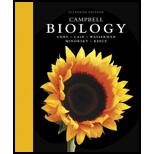
Concept explainers
Describe similarities and differences between protists and other eukaryotes.
To analyze: The similarities and differences between the protists and other eukaryotes.
Introduction: The “endosymbiont theory” predicts that the eukaryotic cells emerged from the engulfing of the early archaebacterial cells and the proteobacterial cells leads to the formation of the eukaryotic cells.
Explanation of Solution
The protists and eukaryotes have many similarities, and it is evident in their structural and functional classifications. It includes a wide variety of organisms present in nature like the diatoms, dinoflagellates, slime molds, golden and brown flagella, ciliates, radiolarians, chlorophytes, amoebas, and the fungi.
The similarities between the protists and other eukaryotes are as follows:
- The presence of organelles like the nucleus, Golgi apparatus, mitochondria, and the lysosomes is evident in the eukaryotic cells like the animal and the plant cells.
- The presence of chlorophyll is evident in the eukaryotic cells like the plant cells.
- The ability to phagocytose cells is called mixotrophy, which resembles the phagocytic activity of the macrophages present inside the human body.
- The sequencing analysis revealed that the mitochondrial genome of the eukaryotes like the plants and animals has emerged from the protists.
- The red, green, and brown algae were phagocytocized by the heterotrophic eukaryotic cells leading to the formation of the new species by the process of secondary endosymbiosis.
The differences between the protists and other eukaryotes are as follows:
| Criteria | Protists | Other Eukaryotes |
| Number of cells | Single or multicellular | Multi-cellular |
| Metabolism | Some species of protists lack the electron transport system and cannot utilize oxygen for the functioning of the metabolism. They use the biochemical pathways for the synthesis of the metabolic food inside the cells. | Other eukaryotes have well developed electron transport system for metabolism. |
| Chloroplast | Chloroplast is present in some protists. | Chloroplast is only present in plants and not in other eukaryotes. |
| Reproduction | Syngamy and meiosis conjugation | Fertilization and meiosis |
Want to see more full solutions like this?
Chapter 28 Solutions
Campbell Biology (11th Edition)
- In one paragraph show how atoms and they're structure are related to the structure of dna and proteins. Talk about what atoms are. what they're made of, why chemical bonding is important to DNA?arrow_forwardWhat are the structure and properties of atoms and chemical bonds (especially how they relate to DNA and proteins).arrow_forwardThe Sentinel Cell: Nature’s Answer to Cancer?arrow_forward
- Molecular Biology Question You are working to characterize a novel protein in mice. Analysis shows that high levels of the primary transcript that codes for this protein are found in tissue from the brain, muscle, liver, and pancreas. However, an antibody that recognizes the C-terminal portion of the protein indicates that the protein is present in brain, muscle, and liver, but not in the pancreas. What is the most likely explanation for this result?arrow_forwardMolecular Biology Explain/discuss how “slow stop” and “quick/fast stop” mutants wereused to identify different protein involved in DNA replication in E. coli.arrow_forwardMolecular Biology Question A gene that codes for a protein was removed from a eukaryotic cell and inserted into a prokaryotic cell. Although the gene was successfully transcribed and translated, it produced a different protein than it produced in the eukaryotic cell. What is the most likely explanation?arrow_forward
- Molecular Biology LIST three characteristics of origins of replicationarrow_forwardMolecular Biology Question Please help. Thank you For E coli DNA polymerase III, give the structure and function of the b-clamp sub-complex. Describe how the structure of this sub-complex is important for it’s function.arrow_forwardMolecular Biology LIST three characteristics of DNA Polymerasesarrow_forward
 Biology: The Dynamic Science (MindTap Course List)BiologyISBN:9781305389892Author:Peter J. Russell, Paul E. Hertz, Beverly McMillanPublisher:Cengage Learning
Biology: The Dynamic Science (MindTap Course List)BiologyISBN:9781305389892Author:Peter J. Russell, Paul E. Hertz, Beverly McMillanPublisher:Cengage Learning Biology 2eBiologyISBN:9781947172517Author:Matthew Douglas, Jung Choi, Mary Ann ClarkPublisher:OpenStax
Biology 2eBiologyISBN:9781947172517Author:Matthew Douglas, Jung Choi, Mary Ann ClarkPublisher:OpenStax Biology (MindTap Course List)BiologyISBN:9781337392938Author:Eldra Solomon, Charles Martin, Diana W. Martin, Linda R. BergPublisher:Cengage Learning
Biology (MindTap Course List)BiologyISBN:9781337392938Author:Eldra Solomon, Charles Martin, Diana W. Martin, Linda R. BergPublisher:Cengage Learning Biology Today and Tomorrow without Physiology (Mi...BiologyISBN:9781305117396Author:Cecie Starr, Christine Evers, Lisa StarrPublisher:Cengage Learning
Biology Today and Tomorrow without Physiology (Mi...BiologyISBN:9781305117396Author:Cecie Starr, Christine Evers, Lisa StarrPublisher:Cengage Learning Concepts of BiologyBiologyISBN:9781938168116Author:Samantha Fowler, Rebecca Roush, James WisePublisher:OpenStax College
Concepts of BiologyBiologyISBN:9781938168116Author:Samantha Fowler, Rebecca Roush, James WisePublisher:OpenStax College





